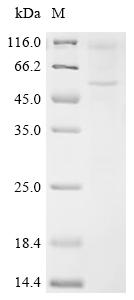Recombinant Mouse 5-hydroxytryptamine receptor 2C (Htr2c)
CAT:
399-CSB-CF010889MO-01
Size:
100 µg
Price:
Ask
- Availability: 24/48H Stock Items & 2 to 6 Weeks non Stock Items.
- Dry Ice Shipment: No




Recombinant Mouse 5-hydroxytryptamine receptor 2C (Htr2c)
- CAS Number: 9000-83-3
- Gene Name: Htr2c
- UniProt: P34968
- Expression Region: 33-459aa
- Organism: Mus musculus
- Target Sequence: IVTDTFNSSDGGRLFQFPDGVQNWPALSIVVIIIMTIGGNILVIMAVSMEKKLHNATNYFLMSLAIADMLVGLLVMPLSLLAILYDYVWPLPRYLCPVWISLDVLFSTASIMHLCAISLDRYVAIRNPIEHSRFNSRTKAIMKIAIVWAISIGVSVPIPVIGLRDESKVFVNNTTCVLNDPNFVLIGSFVAFFIPLTIMVITYFLTIYVLRRQTLMLLRGHTEEELRNISLNFLKCCCKKGDEEENAPNPNPDQKPRRKKKEKRPRGTMQAINNEKKASKVLGIVFFVFLIMWCPFFITNILSVLCGKACNQKLMEKLLNVFVWIGYVCSGINPLVYTLFNKIYRRAFSKYLRCDYKPDKKPPVRQIPRVAATALSGRELNVNIYRHTNERVVRKANDTEPGIEMQVENLELPVNPSNVVSERISSV
- Tag: N-terminal 10xHis-tagged
- Source: in vitro E.coli expression system
- Field of Research: Others
- Assay Type: CF Transmembrane Protein & Developed Protein
- Relevance: G-protein coupled receptor for 5-hydroxytryptamine serotonin. Also functions as a receptor for various drugs and psychoactive substances, including ergot alkaloid derivatives, 1-2, 5, -dimethoxy-4-iodophenyl-2-aminopropane DOI and lysergic acid diethylamide LSD. Ligand binding causes a conformation change that triggers signaling via guanine nucleotide-binding proteins G proteins and modulates the activity of down-stream effectors. Beta-arrestin family members inhibit signaling via G proteins and mediate activation of alternative signaling pathways. Signaling activates a phosphatidylinositol-calcium second messenger system that modulates the activity of phosphatidylinositol 3-kinase and down-stream signaling cascades and promotes the release of Ca2+ ions from intracellular stores. Regulates neuronal activity via the activation of short transient receptor potential calcium channels in the brain, and thereby modulates the activation of pro-opiomelacortin neurons and the release of CRH that then regulates the release of corticosterone. Plays a role in the regulation of appetite and feeding behavior, responses to anXIogenic stimuli and stress. Plays a role in insulin sensitivity and glucose homeostasis.
- Purity: Greater than 85% as determined by SDS-PAGE.
- Activity: Not Test
- Length: Full Length of Mature Protein
- Form: Liquid or Lyophilized powder
- Buffer: If the delivery form is liquid, the default storage buffer is Tris/PBS-based buffer, 5%-50% glycerol. If the delivery form is lyophilized powder, the buffer before lyophilization is Tris/PBS-based buffer, 6% Trehalose, pH 8.0.
- Reconstitution: We recommend that this vial be briefly centrifuged prior to opening to bring the contents to the bottom. Please reconstitute protein in deionized sterile water to a concentration of 0.1-1.0 mg/mL.We recommend to add 5-50% of glycerol (final concentration) and aliquot for long-term storage at -20℃/-80℃. Our default final concentration of glycerol is 50%. Customers could use it as reference.
- Molecular Weight: 54.6 kDa
- Storage Conditions: The shelf life is related to many factors, storage state, buffer ingredients, storage temperature and the stability of the protein itself. Generally, the shelf life of liquid form is 6 months at -20℃/-80℃. The shelf life of lyophilized form is 12 months at -20℃/-80℃.
